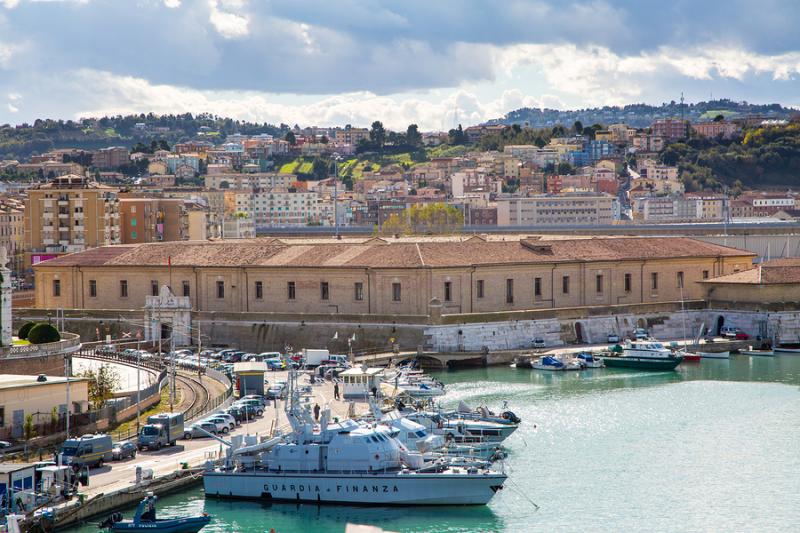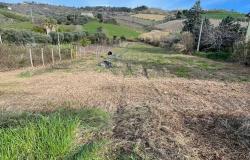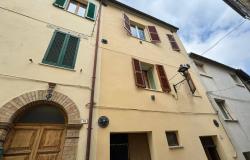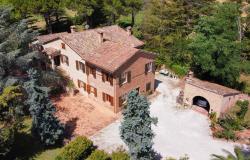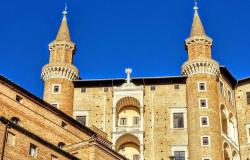Being a port town has been a double-edged sword for Ancona: if, in the past, it made it powerful and strategic, in recent times it has caused a reputation of being, like many port towns, gritty and just plain ugly. But spend a day in this ancient city founded by Greek settlers from Syracuse and you may be pleasantly surprised.
Start your visit at the port, which has been the subject of an urban renewal just recently. A promenade in the nicest area of the ancient port, the north quay, takes you to the landmark ‘Lanterna Rossa’ (Red Beacon); next to it is the ‘panchina degli innamorati’, the ‘lovers’ bench, a great vantage point to gaze out at the sea as it meets the sky. Just below the beacon is an original piece of street art: a mural dedicated to actress Monica Vitti, the protagonist of Mario Monicelli’s The Girl with the Pistol; some of the film's scenes were shot right around the Red Beacon.
Modern meets ancient at the port of Ancona: vestiges of its past as a major harbor and maritime republic abound. The name of the city itself is related to the port area: the word Ancona derives from a Greek word meaning ‘elbow’ as the promontory just to the north of the port is shaped like an elbow. Founded in 387 BC by the Greeks, Ancona later became a Roman municipium and, under emperor Trajan’s rule, turned into a major harbor, considered the western gate to the East. Standing on the north quay is the marble triumphal arch erected in Trajan’s honor in 115, after the war against the Dacians (the Roman army left right from the port of Ancona). The arch would welcome ships approaching what was then Rome's greatest Adriatic port.

Further down is another arch, built many centuries later: the Arco Clementino (Clementine Arch), erected in honor of pope Clemente XII Corsini by the prominent 18th-century architect Luigi Vanvitelli, who took inspiration from Trajan’s arch.
From both arches, you have beautiful views of the port behind you and of the city ahead of you, toward the Guasco hill, where the Duomo dedicated to saint Cyriacus stands. This is one of the most interesting medieval churches in all of Marche. To reach it, you have to climb up the hill; you’ll be rewarded by commanding views of Ancona and its port. Guarded by two marble lions, Ancona’s Cathedral was completed in 1189 and is a mix of Byzantine, Romanesque and Gothic elements, built in the form of a Greek cross, with a dodecagonal dome over the center.

Descend the hill to reach Piazza del Plebiscito, Ancona’s main square since medieval times, dominated by the Baroque church of San Domenico, which guards two magnificent works of art, the Crucifixion by Titian and the Annunciation by Guercino. The statue in front of the church depicts pope Clement XII, honored because he gave Ancona the status of ‘free port’, besides enlarging the port itself. The square is also known as Piazza del Papa.
Not far is the Pinacoteca Comunale, Ancona’s civic art gallery housing Marche’s most important art collection, with paintings arranged by theme rather than chronologically. These include Titian's Pala Gozzi, Lorenzo Lotto’s Sacra Conversazione, Guercino’s Immaculate Conception and St. Palazia, among others.
Walk down Corso Mazzini to see the Renaissance Calamo Fountain, with its 13 masked spouts said to represent those who have been beheaded.

Walk back toward the seafront area to the opposite side of the north quay; you’ll reach the Baroque Porta Pia, the monumental entrance to the town in the late 18th century, commissioned by Pope Pius VI; nearby is the Mole Vanvitelliana, a large building designed by Vanvitelli in 1732 for Pope Clementine, built as a quarantine station to protect the military from the risk of contagious diseases brought into town by ships; today, it hosts cultural exhibits.
For more Marche coverage, see our dedicated page.
